OPS 928 - Coca-Cola Logistics: Planning, Strategies, and Challenges
VerifiedAdded on 2023/06/11
|19
|5864
|240
Report
AI Summary
This report provides a comprehensive analysis of Coca-Cola's logistics system, focusing on the planning and implementation of supply chain activities. It begins with a background of Coca-Cola, including its mission, vision, and market share. The report identifies the approach adopted for planning and implementation, covering techniques used and the focus of investment. It also addresses issues impacting implementation decisions, such as sustainability and transportation challenges, and discusses the benefits and limitations of the implemented strategies. Furthermore, the report explores future trends in Coca-Cola's logistics, including the use of Oracle transportation management and proprietary SAP modules for global operations, and concludes with a summary of the organization's direction moving forward. Desklib provides access to similar solved assignments for students.
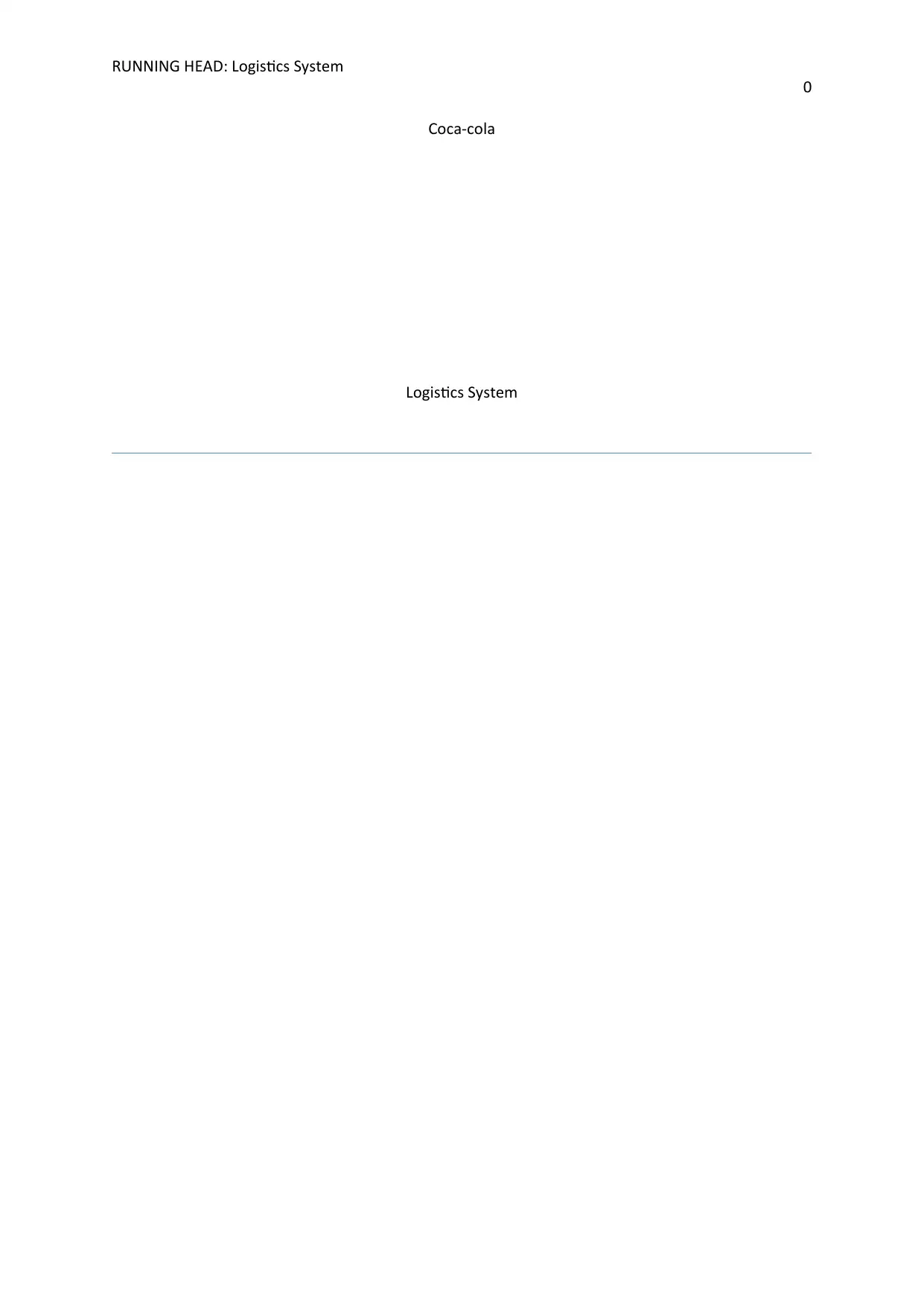
RUNNING HEAD: Logistics System
0
Coca-cola
Logistics System
0
Coca-cola
Logistics System
Paraphrase This Document
Need a fresh take? Get an instant paraphrase of this document with our AI Paraphraser
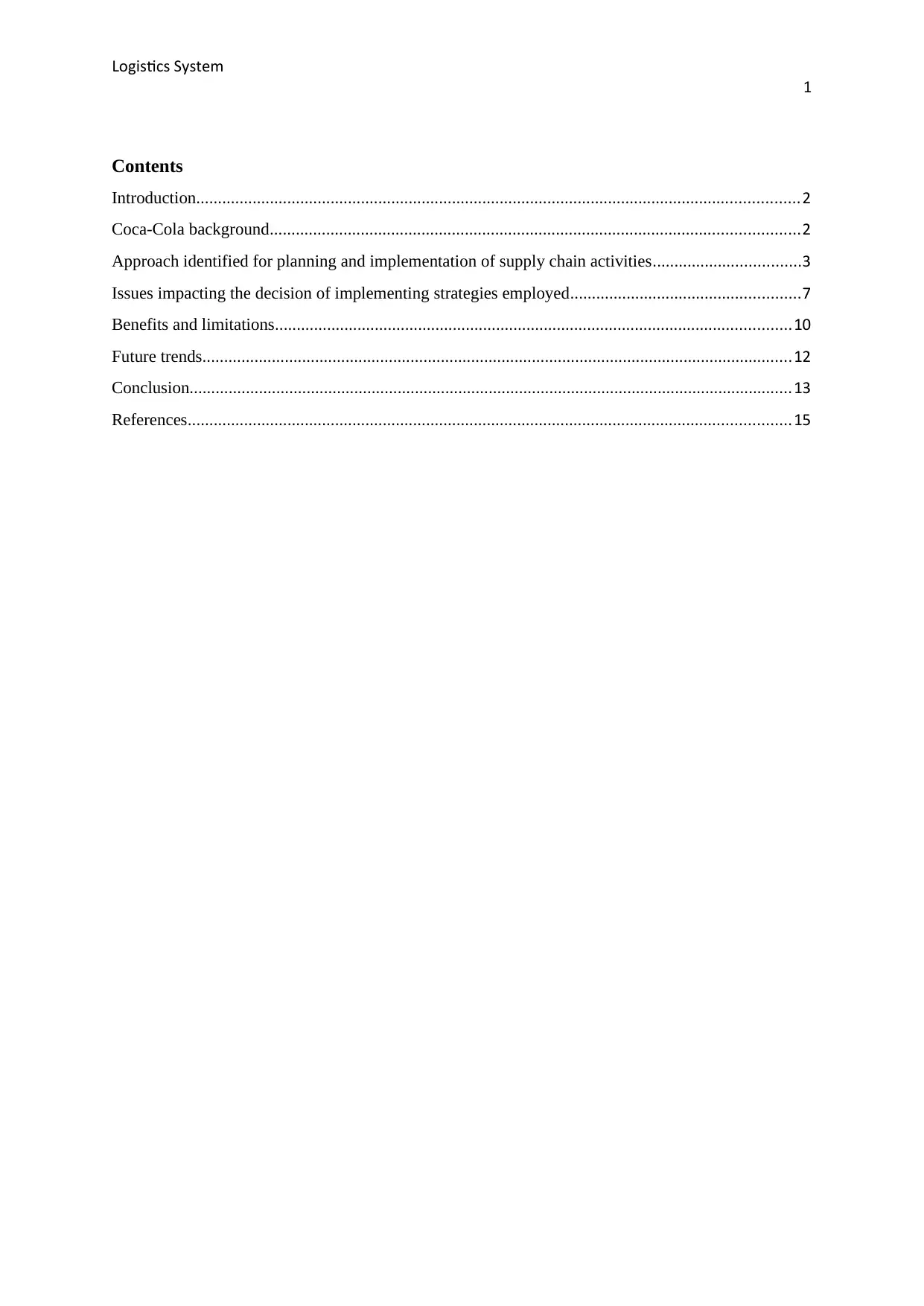
Logistics System
1
Contents
Introduction...........................................................................................................................................2
Coca-Cola background..........................................................................................................................2
Approach identified for planning and implementation of supply chain activities..................................3
Issues impacting the decision of implementing strategies employed.....................................................7
Benefits and limitations.......................................................................................................................10
Future trends........................................................................................................................................12
Conclusion...........................................................................................................................................13
References...........................................................................................................................................15
1
Contents
Introduction...........................................................................................................................................2
Coca-Cola background..........................................................................................................................2
Approach identified for planning and implementation of supply chain activities..................................3
Issues impacting the decision of implementing strategies employed.....................................................7
Benefits and limitations.......................................................................................................................10
Future trends........................................................................................................................................12
Conclusion...........................................................................................................................................13
References...........................................................................................................................................15
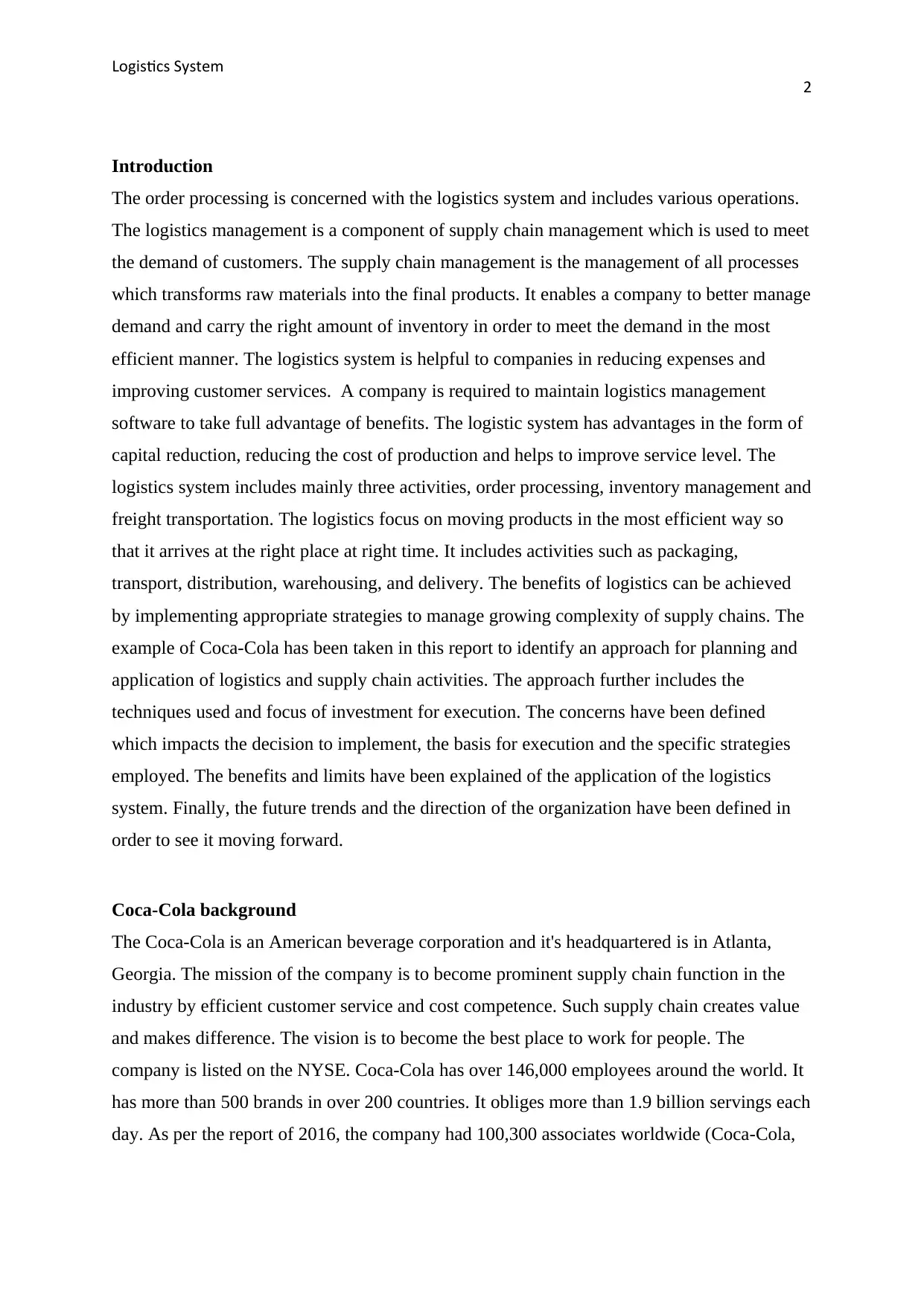
Logistics System
2
Introduction
The order processing is concerned with the logistics system and includes various operations.
The logistics management is a component of supply chain management which is used to meet
the demand of customers. The supply chain management is the management of all processes
which transforms raw materials into the final products. It enables a company to better manage
demand and carry the right amount of inventory in order to meet the demand in the most
efficient manner. The logistics system is helpful to companies in reducing expenses and
improving customer services. A company is required to maintain logistics management
software to take full advantage of benefits. The logistic system has advantages in the form of
capital reduction, reducing the cost of production and helps to improve service level. The
logistics system includes mainly three activities, order processing, inventory management and
freight transportation. The logistics focus on moving products in the most efficient way so
that it arrives at the right place at right time. It includes activities such as packaging,
transport, distribution, warehousing, and delivery. The benefits of logistics can be achieved
by implementing appropriate strategies to manage growing complexity of supply chains. The
example of Coca-Cola has been taken in this report to identify an approach for planning and
application of logistics and supply chain activities. The approach further includes the
techniques used and focus of investment for execution. The concerns have been defined
which impacts the decision to implement, the basis for execution and the specific strategies
employed. The benefits and limits have been explained of the application of the logistics
system. Finally, the future trends and the direction of the organization have been defined in
order to see it moving forward.
Coca-Cola background
The Coca-Cola is an American beverage corporation and it's headquartered is in Atlanta,
Georgia. The mission of the company is to become prominent supply chain function in the
industry by efficient customer service and cost competence. Such supply chain creates value
and makes difference. The vision is to become the best place to work for people. The
company is listed on the NYSE. Coca-Cola has over 146,000 employees around the world. It
has more than 500 brands in over 200 countries. It obliges more than 1.9 billion servings each
day. As per the report of 2016, the company had 100,300 associates worldwide (Coca-Cola,
2
Introduction
The order processing is concerned with the logistics system and includes various operations.
The logistics management is a component of supply chain management which is used to meet
the demand of customers. The supply chain management is the management of all processes
which transforms raw materials into the final products. It enables a company to better manage
demand and carry the right amount of inventory in order to meet the demand in the most
efficient manner. The logistics system is helpful to companies in reducing expenses and
improving customer services. A company is required to maintain logistics management
software to take full advantage of benefits. The logistic system has advantages in the form of
capital reduction, reducing the cost of production and helps to improve service level. The
logistics system includes mainly three activities, order processing, inventory management and
freight transportation. The logistics focus on moving products in the most efficient way so
that it arrives at the right place at right time. It includes activities such as packaging,
transport, distribution, warehousing, and delivery. The benefits of logistics can be achieved
by implementing appropriate strategies to manage growing complexity of supply chains. The
example of Coca-Cola has been taken in this report to identify an approach for planning and
application of logistics and supply chain activities. The approach further includes the
techniques used and focus of investment for execution. The concerns have been defined
which impacts the decision to implement, the basis for execution and the specific strategies
employed. The benefits and limits have been explained of the application of the logistics
system. Finally, the future trends and the direction of the organization have been defined in
order to see it moving forward.
Coca-Cola background
The Coca-Cola is an American beverage corporation and it's headquartered is in Atlanta,
Georgia. The mission of the company is to become prominent supply chain function in the
industry by efficient customer service and cost competence. Such supply chain creates value
and makes difference. The vision is to become the best place to work for people. The
company is listed on the NYSE. Coca-Cola has over 146,000 employees around the world. It
has more than 500 brands in over 200 countries. It obliges more than 1.9 billion servings each
day. As per the report of 2016, the company had 100,300 associates worldwide (Coca-Cola,
⊘ This is a preview!⊘
Do you want full access?
Subscribe today to unlock all pages.

Trusted by 1+ million students worldwide
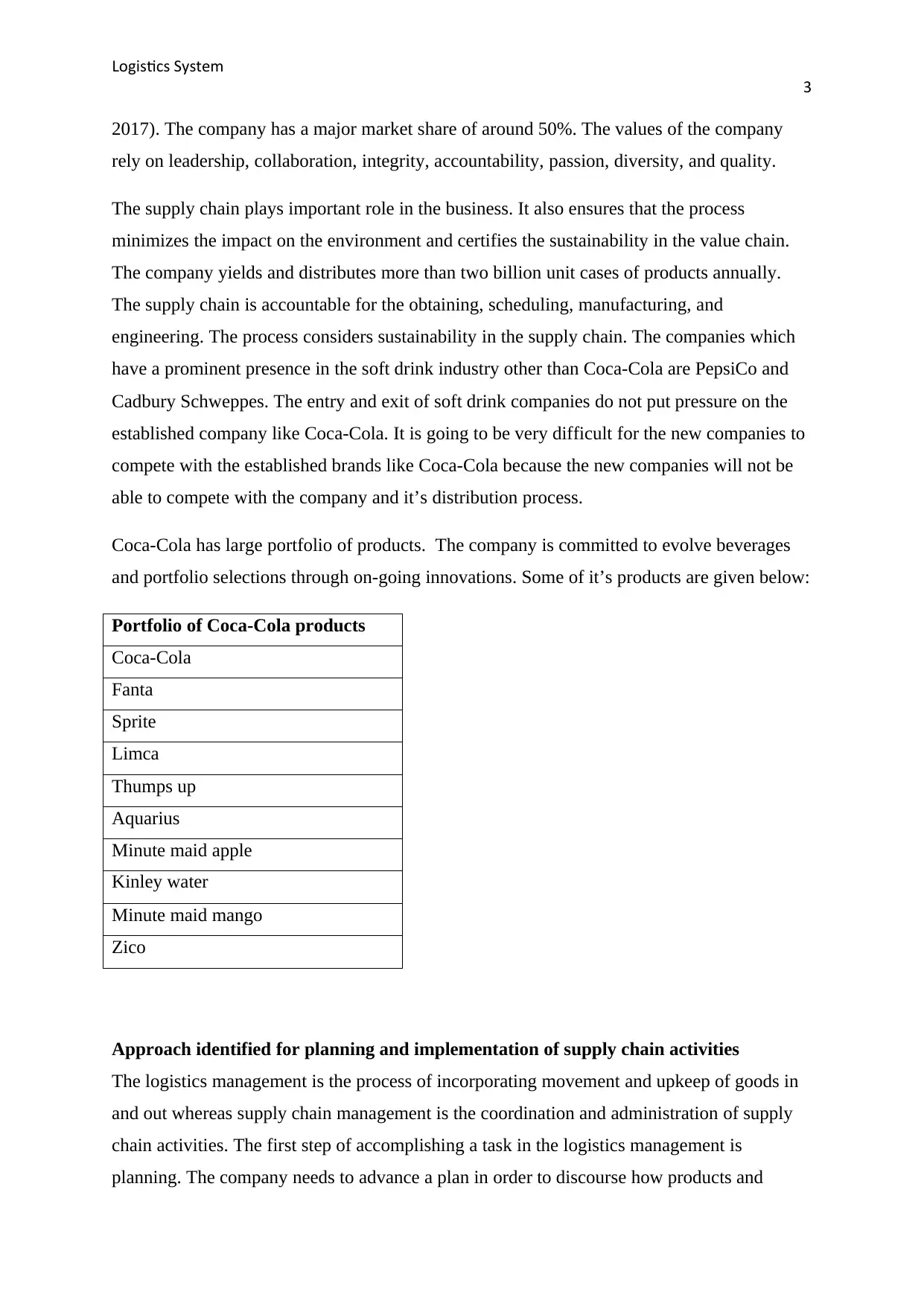
Logistics System
3
2017). The company has a major market share of around 50%. The values of the company
rely on leadership, collaboration, integrity, accountability, passion, diversity, and quality.
The supply chain plays important role in the business. It also ensures that the process
minimizes the impact on the environment and certifies the sustainability in the value chain.
The company yields and distributes more than two billion unit cases of products annually.
The supply chain is accountable for the obtaining, scheduling, manufacturing, and
engineering. The process considers sustainability in the supply chain. The companies which
have a prominent presence in the soft drink industry other than Coca-Cola are PepsiCo and
Cadbury Schweppes. The entry and exit of soft drink companies do not put pressure on the
established company like Coca-Cola. It is going to be very difficult for the new companies to
compete with the established brands like Coca-Cola because the new companies will not be
able to compete with the company and it’s distribution process.
Coca-Cola has large portfolio of products. The company is committed to evolve beverages
and portfolio selections through on-going innovations. Some of it’s products are given below:
Portfolio of Coca-Cola products
Coca-Cola
Fanta
Sprite
Limca
Thumps up
Aquarius
Minute maid apple
Kinley water
Minute maid mango
Zico
Approach identified for planning and implementation of supply chain activities
The logistics management is the process of incorporating movement and upkeep of goods in
and out whereas supply chain management is the coordination and administration of supply
chain activities. The first step of accomplishing a task in the logistics management is
planning. The company needs to advance a plan in order to discourse how products and
3
2017). The company has a major market share of around 50%. The values of the company
rely on leadership, collaboration, integrity, accountability, passion, diversity, and quality.
The supply chain plays important role in the business. It also ensures that the process
minimizes the impact on the environment and certifies the sustainability in the value chain.
The company yields and distributes more than two billion unit cases of products annually.
The supply chain is accountable for the obtaining, scheduling, manufacturing, and
engineering. The process considers sustainability in the supply chain. The companies which
have a prominent presence in the soft drink industry other than Coca-Cola are PepsiCo and
Cadbury Schweppes. The entry and exit of soft drink companies do not put pressure on the
established company like Coca-Cola. It is going to be very difficult for the new companies to
compete with the established brands like Coca-Cola because the new companies will not be
able to compete with the company and it’s distribution process.
Coca-Cola has large portfolio of products. The company is committed to evolve beverages
and portfolio selections through on-going innovations. Some of it’s products are given below:
Portfolio of Coca-Cola products
Coca-Cola
Fanta
Sprite
Limca
Thumps up
Aquarius
Minute maid apple
Kinley water
Minute maid mango
Zico
Approach identified for planning and implementation of supply chain activities
The logistics management is the process of incorporating movement and upkeep of goods in
and out whereas supply chain management is the coordination and administration of supply
chain activities. The first step of accomplishing a task in the logistics management is
planning. The company needs to advance a plan in order to discourse how products and
Paraphrase This Document
Need a fresh take? Get an instant paraphrase of this document with our AI Paraphraser
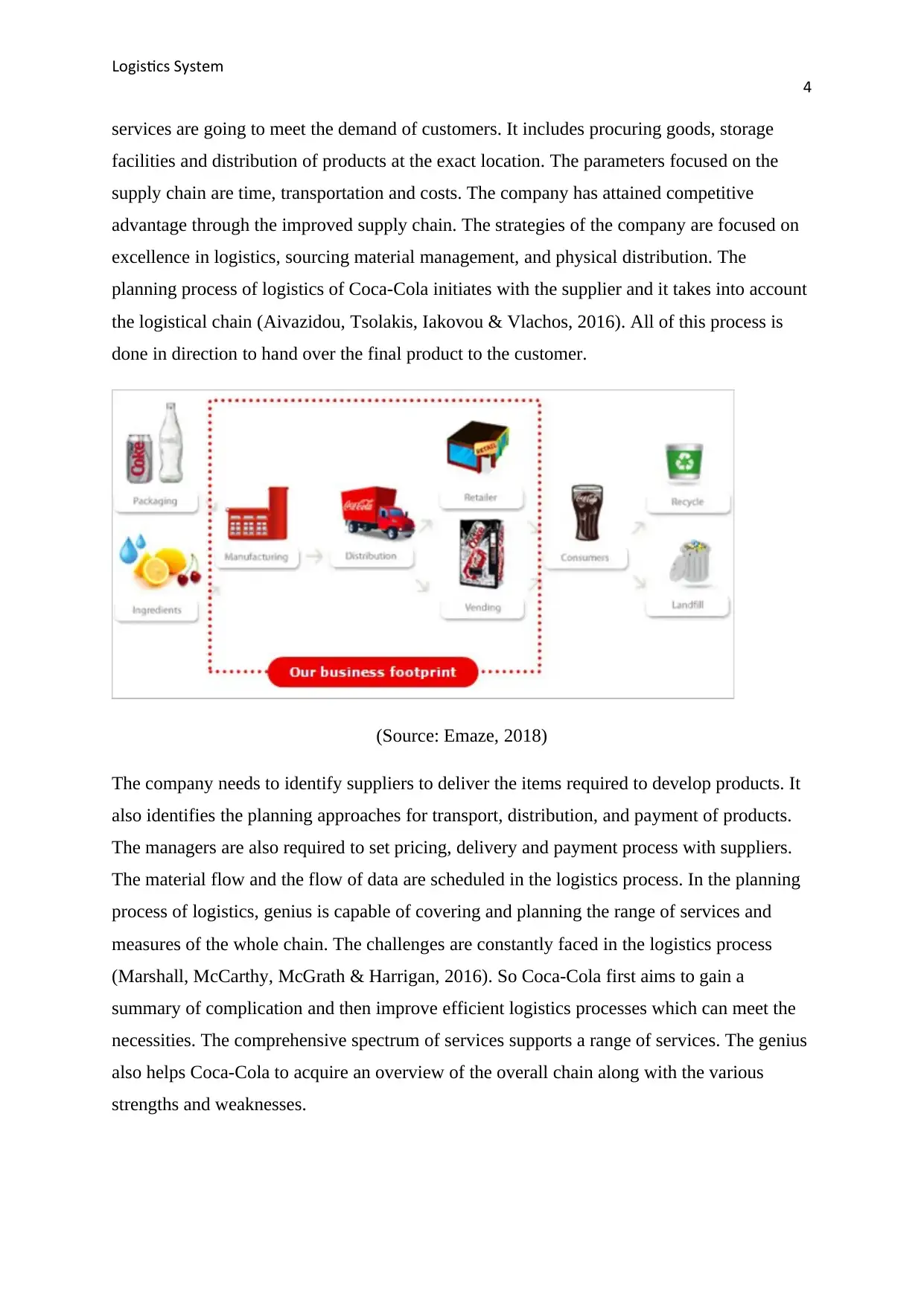
Logistics System
4
services are going to meet the demand of customers. It includes procuring goods, storage
facilities and distribution of products at the exact location. The parameters focused on the
supply chain are time, transportation and costs. The company has attained competitive
advantage through the improved supply chain. The strategies of the company are focused on
excellence in logistics, sourcing material management, and physical distribution. The
planning process of logistics of Coca-Cola initiates with the supplier and it takes into account
the logistical chain (Aivazidou, Tsolakis, Iakovou & Vlachos, 2016). All of this process is
done in direction to hand over the final product to the customer.
(Source: Emaze, 2018)
The company needs to identify suppliers to deliver the items required to develop products. It
also identifies the planning approaches for transport, distribution, and payment of products.
The managers are also required to set pricing, delivery and payment process with suppliers.
The material flow and the flow of data are scheduled in the logistics process. In the planning
process of logistics, genius is capable of covering and planning the range of services and
measures of the whole chain. The challenges are constantly faced in the logistics process
(Marshall, McCarthy, McGrath & Harrigan, 2016). So Coca-Cola first aims to gain a
summary of complication and then improve efficient logistics processes which can meet the
necessities. The comprehensive spectrum of services supports a range of services. The genius
also helps Coca-Cola to acquire an overview of the overall chain along with the various
strengths and weaknesses.
4
services are going to meet the demand of customers. It includes procuring goods, storage
facilities and distribution of products at the exact location. The parameters focused on the
supply chain are time, transportation and costs. The company has attained competitive
advantage through the improved supply chain. The strategies of the company are focused on
excellence in logistics, sourcing material management, and physical distribution. The
planning process of logistics of Coca-Cola initiates with the supplier and it takes into account
the logistical chain (Aivazidou, Tsolakis, Iakovou & Vlachos, 2016). All of this process is
done in direction to hand over the final product to the customer.
(Source: Emaze, 2018)
The company needs to identify suppliers to deliver the items required to develop products. It
also identifies the planning approaches for transport, distribution, and payment of products.
The managers are also required to set pricing, delivery and payment process with suppliers.
The material flow and the flow of data are scheduled in the logistics process. In the planning
process of logistics, genius is capable of covering and planning the range of services and
measures of the whole chain. The challenges are constantly faced in the logistics process
(Marshall, McCarthy, McGrath & Harrigan, 2016). So Coca-Cola first aims to gain a
summary of complication and then improve efficient logistics processes which can meet the
necessities. The comprehensive spectrum of services supports a range of services. The genius
also helps Coca-Cola to acquire an overview of the overall chain along with the various
strengths and weaknesses.
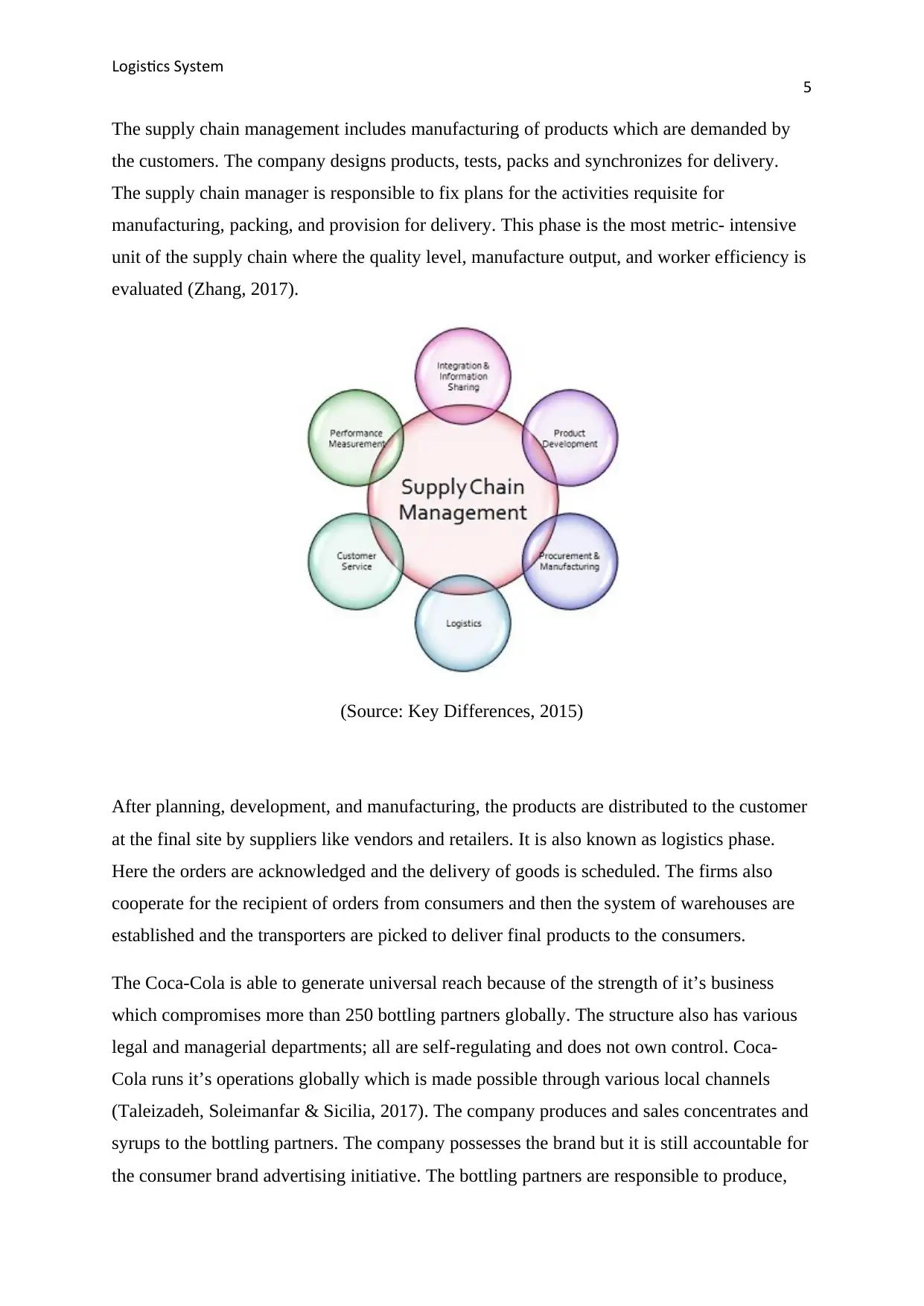
Logistics System
5
The supply chain management includes manufacturing of products which are demanded by
the customers. The company designs products, tests, packs and synchronizes for delivery.
The supply chain manager is responsible to fix plans for the activities requisite for
manufacturing, packing, and provision for delivery. This phase is the most metric- intensive
unit of the supply chain where the quality level, manufacture output, and worker efficiency is
evaluated (Zhang, 2017).
(Source: Key Differences, 2015)
After planning, development, and manufacturing, the products are distributed to the customer
at the final site by suppliers like vendors and retailers. It is also known as logistics phase.
Here the orders are acknowledged and the delivery of goods is scheduled. The firms also
cooperate for the recipient of orders from consumers and then the system of warehouses are
established and the transporters are picked to deliver final products to the consumers.
The Coca-Cola is able to generate universal reach because of the strength of it’s business
which compromises more than 250 bottling partners globally. The structure also has various
legal and managerial departments; all are self-regulating and does not own control. Coca-
Cola runs it’s operations globally which is made possible through various local channels
(Taleizadeh, Soleimanfar & Sicilia, 2017). The company produces and sales concentrates and
syrups to the bottling partners. The company possesses the brand but it is still accountable for
the consumer brand advertising initiative. The bottling partners are responsible to produce,
5
The supply chain management includes manufacturing of products which are demanded by
the customers. The company designs products, tests, packs and synchronizes for delivery.
The supply chain manager is responsible to fix plans for the activities requisite for
manufacturing, packing, and provision for delivery. This phase is the most metric- intensive
unit of the supply chain where the quality level, manufacture output, and worker efficiency is
evaluated (Zhang, 2017).
(Source: Key Differences, 2015)
After planning, development, and manufacturing, the products are distributed to the customer
at the final site by suppliers like vendors and retailers. It is also known as logistics phase.
Here the orders are acknowledged and the delivery of goods is scheduled. The firms also
cooperate for the recipient of orders from consumers and then the system of warehouses are
established and the transporters are picked to deliver final products to the consumers.
The Coca-Cola is able to generate universal reach because of the strength of it’s business
which compromises more than 250 bottling partners globally. The structure also has various
legal and managerial departments; all are self-regulating and does not own control. Coca-
Cola runs it’s operations globally which is made possible through various local channels
(Taleizadeh, Soleimanfar & Sicilia, 2017). The company produces and sales concentrates and
syrups to the bottling partners. The company possesses the brand but it is still accountable for
the consumer brand advertising initiative. The bottling partners are responsible to produce,
⊘ This is a preview!⊘
Do you want full access?
Subscribe today to unlock all pages.

Trusted by 1+ million students worldwide
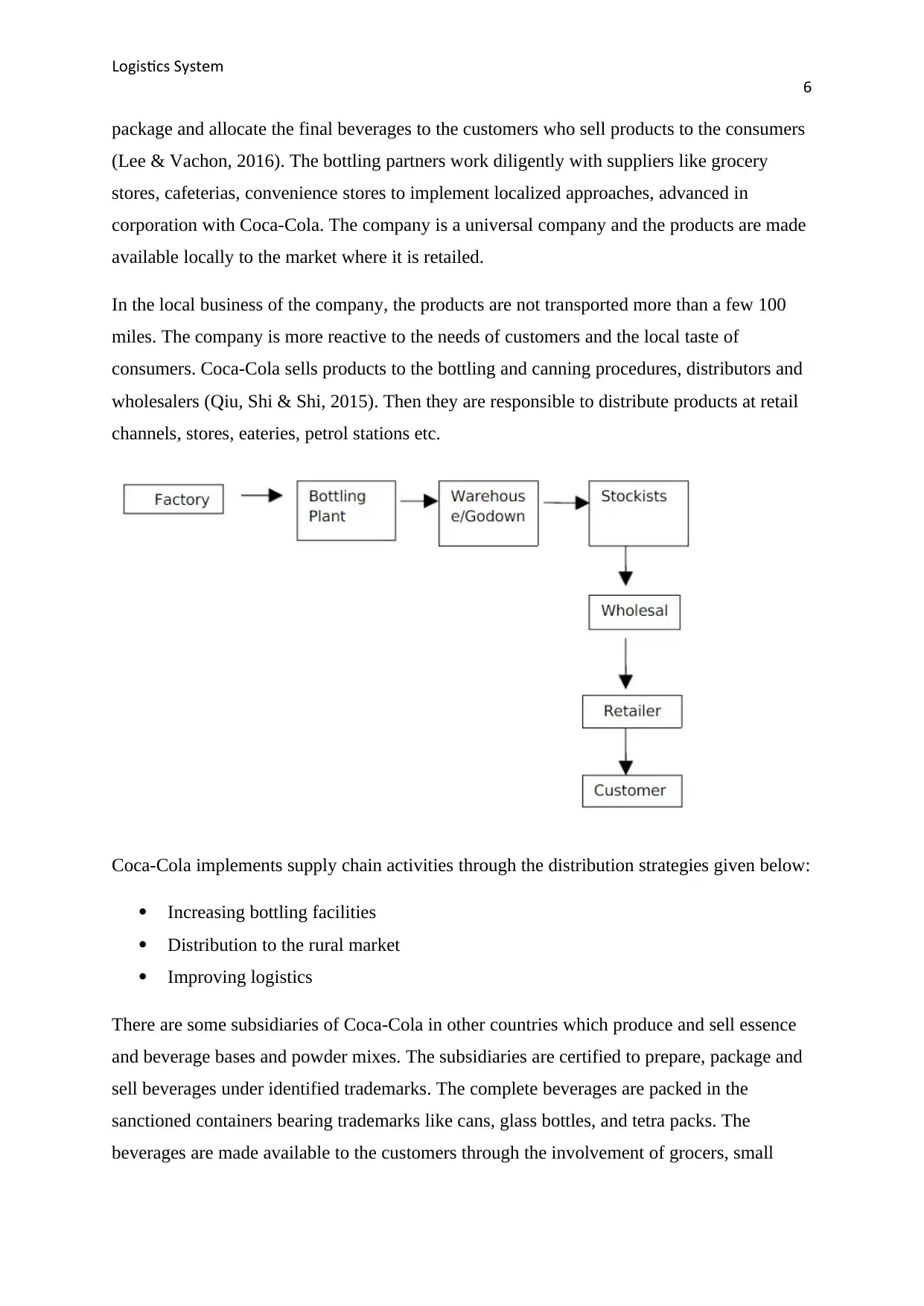
Logistics System
6
package and allocate the final beverages to the customers who sell products to the consumers
(Lee & Vachon, 2016). The bottling partners work diligently with suppliers like grocery
stores, cafeterias, convenience stores to implement localized approaches, advanced in
corporation with Coca-Cola. The company is a universal company and the products are made
available locally to the market where it is retailed.
In the local business of the company, the products are not transported more than a few 100
miles. The company is more reactive to the needs of customers and the local taste of
consumers. Coca-Cola sells products to the bottling and canning procedures, distributors and
wholesalers (Qiu, Shi & Shi, 2015). Then they are responsible to distribute products at retail
channels, stores, eateries, petrol stations etc.
Coca-Cola implements supply chain activities through the distribution strategies given below:
Increasing bottling facilities
Distribution to the rural market
Improving logistics
There are some subsidiaries of Coca-Cola in other countries which produce and sell essence
and beverage bases and powder mixes. The subsidiaries are certified to prepare, package and
sell beverages under identified trademarks. The complete beverages are packed in the
sanctioned containers bearing trademarks like cans, glass bottles, and tetra packs. The
beverages are made available to the customers through the involvement of grocers, small
6
package and allocate the final beverages to the customers who sell products to the consumers
(Lee & Vachon, 2016). The bottling partners work diligently with suppliers like grocery
stores, cafeterias, convenience stores to implement localized approaches, advanced in
corporation with Coca-Cola. The company is a universal company and the products are made
available locally to the market where it is retailed.
In the local business of the company, the products are not transported more than a few 100
miles. The company is more reactive to the needs of customers and the local taste of
consumers. Coca-Cola sells products to the bottling and canning procedures, distributors and
wholesalers (Qiu, Shi & Shi, 2015). Then they are responsible to distribute products at retail
channels, stores, eateries, petrol stations etc.
Coca-Cola implements supply chain activities through the distribution strategies given below:
Increasing bottling facilities
Distribution to the rural market
Improving logistics
There are some subsidiaries of Coca-Cola in other countries which produce and sell essence
and beverage bases and powder mixes. The subsidiaries are certified to prepare, package and
sell beverages under identified trademarks. The complete beverages are packed in the
sanctioned containers bearing trademarks like cans, glass bottles, and tetra packs. The
beverages are made available to the customers through the involvement of grocers, small
Paraphrase This Document
Need a fresh take? Get an instant paraphrase of this document with our AI Paraphraser
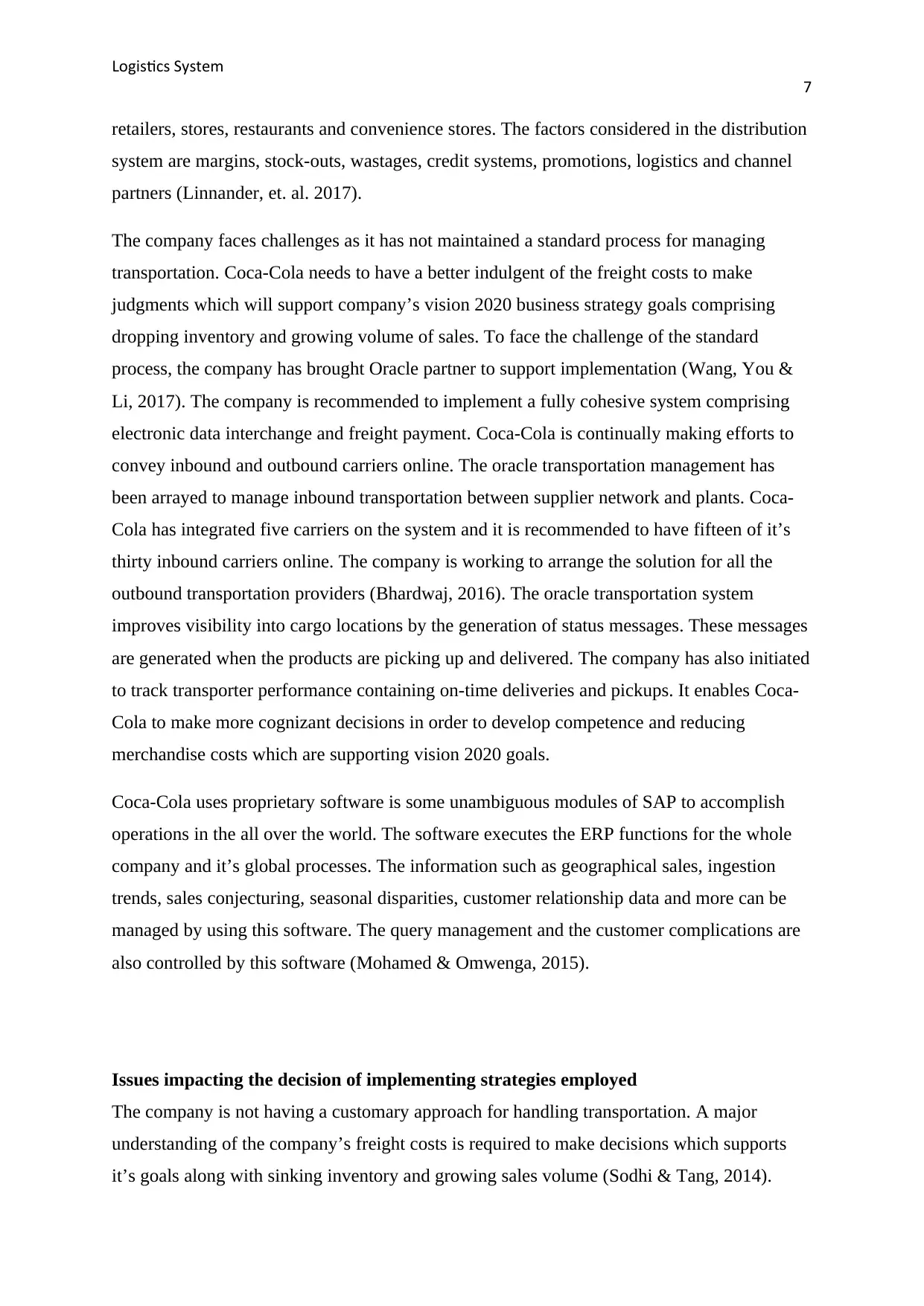
Logistics System
7
retailers, stores, restaurants and convenience stores. The factors considered in the distribution
system are margins, stock-outs, wastages, credit systems, promotions, logistics and channel
partners (Linnander, et. al. 2017).
The company faces challenges as it has not maintained a standard process for managing
transportation. Coca-Cola needs to have a better indulgent of the freight costs to make
judgments which will support company’s vision 2020 business strategy goals comprising
dropping inventory and growing volume of sales. To face the challenge of the standard
process, the company has brought Oracle partner to support implementation (Wang, You &
Li, 2017). The company is recommended to implement a fully cohesive system comprising
electronic data interchange and freight payment. Coca-Cola is continually making efforts to
convey inbound and outbound carriers online. The oracle transportation management has
been arrayed to manage inbound transportation between supplier network and plants. Coca-
Cola has integrated five carriers on the system and it is recommended to have fifteen of it’s
thirty inbound carriers online. The company is working to arrange the solution for all the
outbound transportation providers (Bhardwaj, 2016). The oracle transportation system
improves visibility into cargo locations by the generation of status messages. These messages
are generated when the products are picking up and delivered. The company has also initiated
to track transporter performance containing on-time deliveries and pickups. It enables Coca-
Cola to make more cognizant decisions in order to develop competence and reducing
merchandise costs which are supporting vision 2020 goals.
Coca-Cola uses proprietary software is some unambiguous modules of SAP to accomplish
operations in the all over the world. The software executes the ERP functions for the whole
company and it’s global processes. The information such as geographical sales, ingestion
trends, sales conjecturing, seasonal disparities, customer relationship data and more can be
managed by using this software. The query management and the customer complications are
also controlled by this software (Mohamed & Omwenga, 2015).
Issues impacting the decision of implementing strategies employed
The company is not having a customary approach for handling transportation. A major
understanding of the company’s freight costs is required to make decisions which supports
it’s goals along with sinking inventory and growing sales volume (Sodhi & Tang, 2014).
7
retailers, stores, restaurants and convenience stores. The factors considered in the distribution
system are margins, stock-outs, wastages, credit systems, promotions, logistics and channel
partners (Linnander, et. al. 2017).
The company faces challenges as it has not maintained a standard process for managing
transportation. Coca-Cola needs to have a better indulgent of the freight costs to make
judgments which will support company’s vision 2020 business strategy goals comprising
dropping inventory and growing volume of sales. To face the challenge of the standard
process, the company has brought Oracle partner to support implementation (Wang, You &
Li, 2017). The company is recommended to implement a fully cohesive system comprising
electronic data interchange and freight payment. Coca-Cola is continually making efforts to
convey inbound and outbound carriers online. The oracle transportation management has
been arrayed to manage inbound transportation between supplier network and plants. Coca-
Cola has integrated five carriers on the system and it is recommended to have fifteen of it’s
thirty inbound carriers online. The company is working to arrange the solution for all the
outbound transportation providers (Bhardwaj, 2016). The oracle transportation system
improves visibility into cargo locations by the generation of status messages. These messages
are generated when the products are picking up and delivered. The company has also initiated
to track transporter performance containing on-time deliveries and pickups. It enables Coca-
Cola to make more cognizant decisions in order to develop competence and reducing
merchandise costs which are supporting vision 2020 goals.
Coca-Cola uses proprietary software is some unambiguous modules of SAP to accomplish
operations in the all over the world. The software executes the ERP functions for the whole
company and it’s global processes. The information such as geographical sales, ingestion
trends, sales conjecturing, seasonal disparities, customer relationship data and more can be
managed by using this software. The query management and the customer complications are
also controlled by this software (Mohamed & Omwenga, 2015).
Issues impacting the decision of implementing strategies employed
The company is not having a customary approach for handling transportation. A major
understanding of the company’s freight costs is required to make decisions which supports
it’s goals along with sinking inventory and growing sales volume (Sodhi & Tang, 2014).
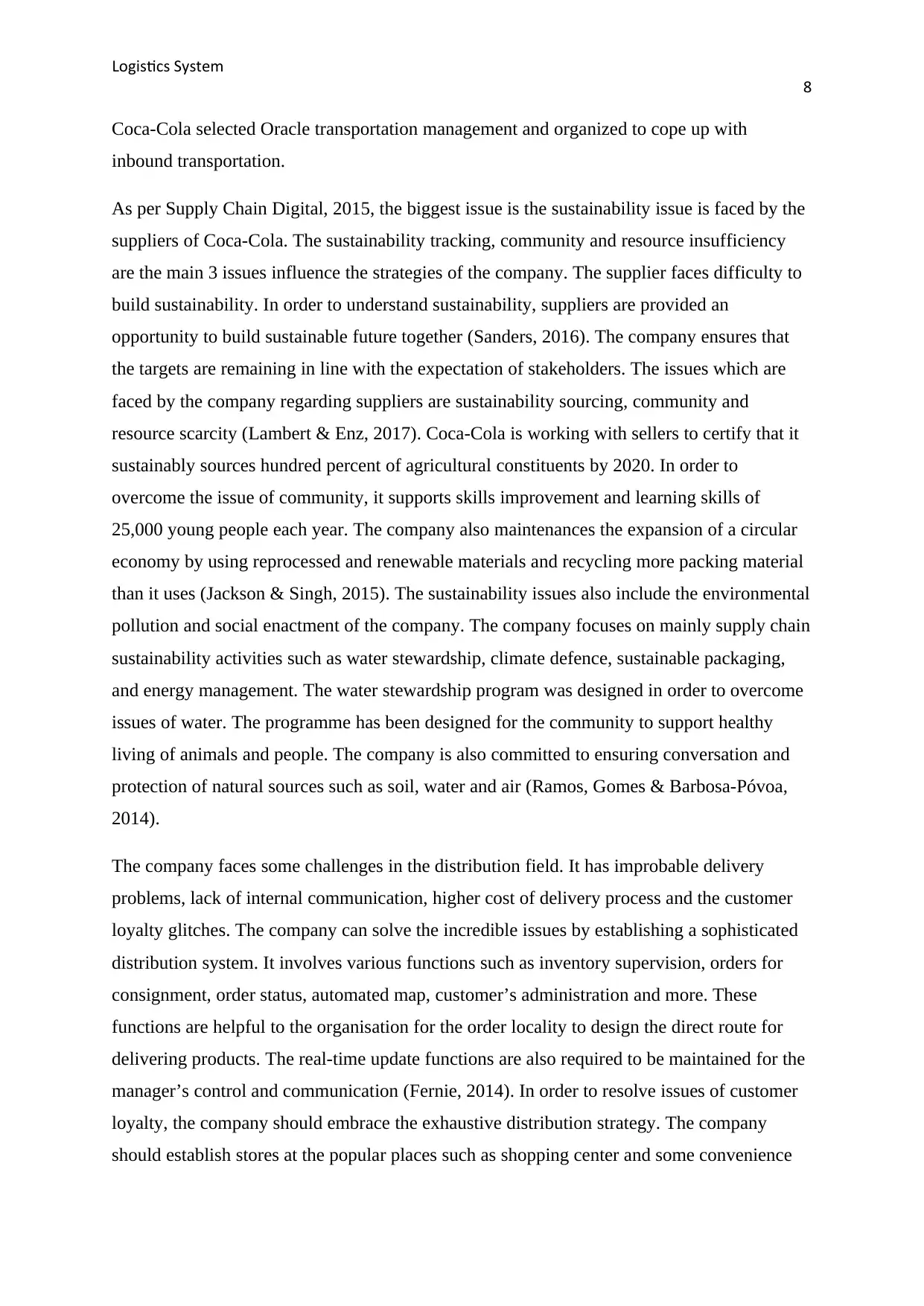
Logistics System
8
Coca-Cola selected Oracle transportation management and organized to cope up with
inbound transportation.
As per Supply Chain Digital, 2015, the biggest issue is the sustainability issue is faced by the
suppliers of Coca-Cola. The sustainability tracking, community and resource insufficiency
are the main 3 issues influence the strategies of the company. The supplier faces difficulty to
build sustainability. In order to understand sustainability, suppliers are provided an
opportunity to build sustainable future together (Sanders, 2016). The company ensures that
the targets are remaining in line with the expectation of stakeholders. The issues which are
faced by the company regarding suppliers are sustainability sourcing, community and
resource scarcity (Lambert & Enz, 2017). Coca-Cola is working with sellers to certify that it
sustainably sources hundred percent of agricultural constituents by 2020. In order to
overcome the issue of community, it supports skills improvement and learning skills of
25,000 young people each year. The company also maintenances the expansion of a circular
economy by using reprocessed and renewable materials and recycling more packing material
than it uses (Jackson & Singh, 2015). The sustainability issues also include the environmental
pollution and social enactment of the company. The company focuses on mainly supply chain
sustainability activities such as water stewardship, climate defence, sustainable packaging,
and energy management. The water stewardship program was designed in order to overcome
issues of water. The programme has been designed for the community to support healthy
living of animals and people. The company is also committed to ensuring conversation and
protection of natural sources such as soil, water and air (Ramos, Gomes & Barbosa-Póvoa,
2014).
The company faces some challenges in the distribution field. It has improbable delivery
problems, lack of internal communication, higher cost of delivery process and the customer
loyalty glitches. The company can solve the incredible issues by establishing a sophisticated
distribution system. It involves various functions such as inventory supervision, orders for
consignment, order status, automated map, customer’s administration and more. These
functions are helpful to the organisation for the order locality to design the direct route for
delivering products. The real-time update functions are also required to be maintained for the
manager’s control and communication (Fernie, 2014). In order to resolve issues of customer
loyalty, the company should embrace the exhaustive distribution strategy. The company
should establish stores at the popular places such as shopping center and some convenience
8
Coca-Cola selected Oracle transportation management and organized to cope up with
inbound transportation.
As per Supply Chain Digital, 2015, the biggest issue is the sustainability issue is faced by the
suppliers of Coca-Cola. The sustainability tracking, community and resource insufficiency
are the main 3 issues influence the strategies of the company. The supplier faces difficulty to
build sustainability. In order to understand sustainability, suppliers are provided an
opportunity to build sustainable future together (Sanders, 2016). The company ensures that
the targets are remaining in line with the expectation of stakeholders. The issues which are
faced by the company regarding suppliers are sustainability sourcing, community and
resource scarcity (Lambert & Enz, 2017). Coca-Cola is working with sellers to certify that it
sustainably sources hundred percent of agricultural constituents by 2020. In order to
overcome the issue of community, it supports skills improvement and learning skills of
25,000 young people each year. The company also maintenances the expansion of a circular
economy by using reprocessed and renewable materials and recycling more packing material
than it uses (Jackson & Singh, 2015). The sustainability issues also include the environmental
pollution and social enactment of the company. The company focuses on mainly supply chain
sustainability activities such as water stewardship, climate defence, sustainable packaging,
and energy management. The water stewardship program was designed in order to overcome
issues of water. The programme has been designed for the community to support healthy
living of animals and people. The company is also committed to ensuring conversation and
protection of natural sources such as soil, water and air (Ramos, Gomes & Barbosa-Póvoa,
2014).
The company faces some challenges in the distribution field. It has improbable delivery
problems, lack of internal communication, higher cost of delivery process and the customer
loyalty glitches. The company can solve the incredible issues by establishing a sophisticated
distribution system. It involves various functions such as inventory supervision, orders for
consignment, order status, automated map, customer’s administration and more. These
functions are helpful to the organisation for the order locality to design the direct route for
delivering products. The real-time update functions are also required to be maintained for the
manager’s control and communication (Fernie, 2014). In order to resolve issues of customer
loyalty, the company should embrace the exhaustive distribution strategy. The company
should establish stores at the popular places such as shopping center and some convenience
⊘ This is a preview!⊘
Do you want full access?
Subscribe today to unlock all pages.

Trusted by 1+ million students worldwide
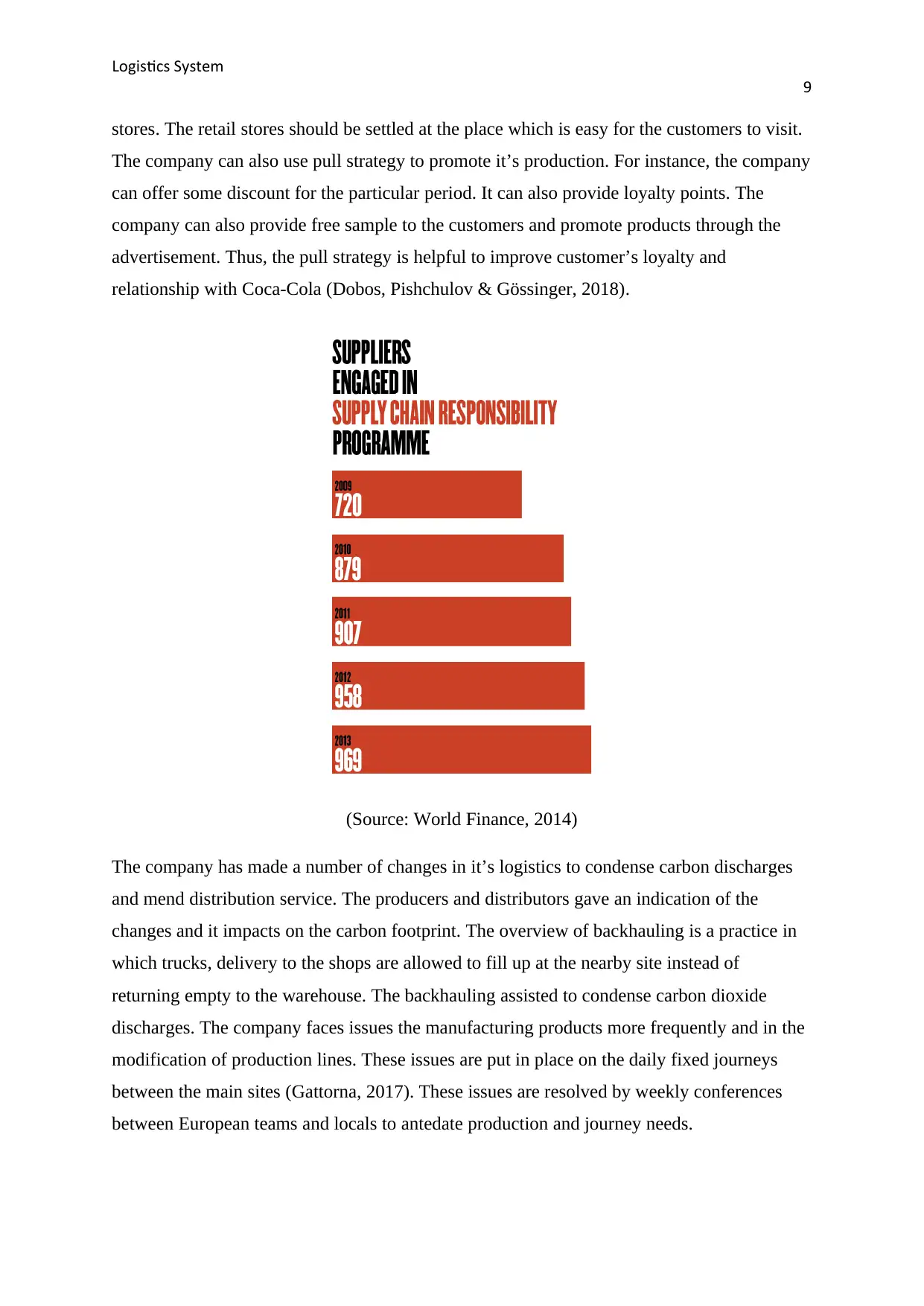
Logistics System
9
stores. The retail stores should be settled at the place which is easy for the customers to visit.
The company can also use pull strategy to promote it’s production. For instance, the company
can offer some discount for the particular period. It can also provide loyalty points. The
company can also provide free sample to the customers and promote products through the
advertisement. Thus, the pull strategy is helpful to improve customer’s loyalty and
relationship with Coca-Cola (Dobos, Pishchulov & Gössinger, 2018).
(Source: World Finance, 2014)
The company has made a number of changes in it’s logistics to condense carbon discharges
and mend distribution service. The producers and distributors gave an indication of the
changes and it impacts on the carbon footprint. The overview of backhauling is a practice in
which trucks, delivery to the shops are allowed to fill up at the nearby site instead of
returning empty to the warehouse. The backhauling assisted to condense carbon dioxide
discharges. The company faces issues the manufacturing products more frequently and in the
modification of production lines. These issues are put in place on the daily fixed journeys
between the main sites (Gattorna, 2017). These issues are resolved by weekly conferences
between European teams and locals to antedate production and journey needs.
9
stores. The retail stores should be settled at the place which is easy for the customers to visit.
The company can also use pull strategy to promote it’s production. For instance, the company
can offer some discount for the particular period. It can also provide loyalty points. The
company can also provide free sample to the customers and promote products through the
advertisement. Thus, the pull strategy is helpful to improve customer’s loyalty and
relationship with Coca-Cola (Dobos, Pishchulov & Gössinger, 2018).
(Source: World Finance, 2014)
The company has made a number of changes in it’s logistics to condense carbon discharges
and mend distribution service. The producers and distributors gave an indication of the
changes and it impacts on the carbon footprint. The overview of backhauling is a practice in
which trucks, delivery to the shops are allowed to fill up at the nearby site instead of
returning empty to the warehouse. The backhauling assisted to condense carbon dioxide
discharges. The company faces issues the manufacturing products more frequently and in the
modification of production lines. These issues are put in place on the daily fixed journeys
between the main sites (Gattorna, 2017). These issues are resolved by weekly conferences
between European teams and locals to antedate production and journey needs.
Paraphrase This Document
Need a fresh take? Get an instant paraphrase of this document with our AI Paraphraser
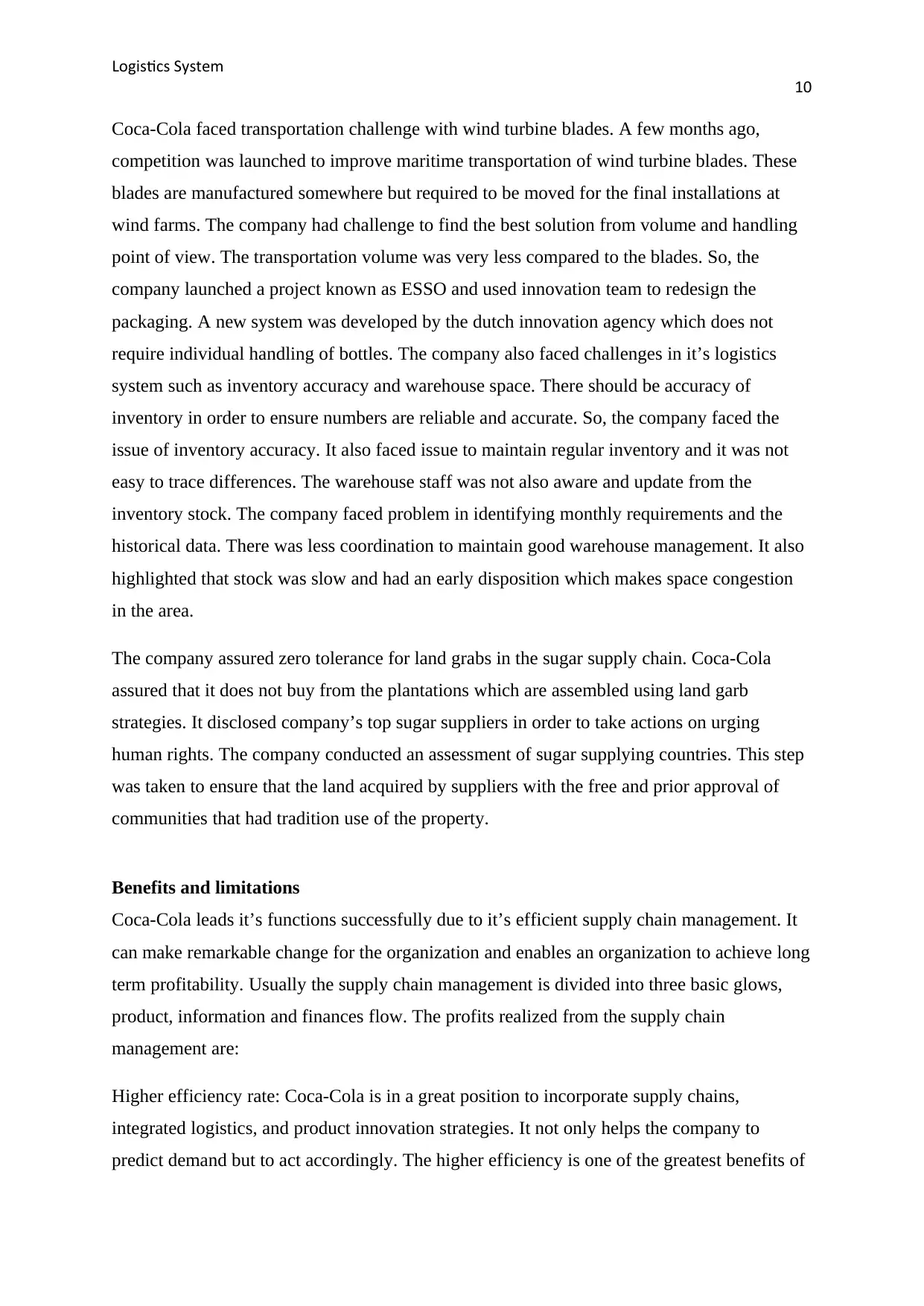
Logistics System
10
Coca-Cola faced transportation challenge with wind turbine blades. A few months ago,
competition was launched to improve maritime transportation of wind turbine blades. These
blades are manufactured somewhere but required to be moved for the final installations at
wind farms. The company had challenge to find the best solution from volume and handling
point of view. The transportation volume was very less compared to the blades. So, the
company launched a project known as ESSO and used innovation team to redesign the
packaging. A new system was developed by the dutch innovation agency which does not
require individual handling of bottles. The company also faced challenges in it’s logistics
system such as inventory accuracy and warehouse space. There should be accuracy of
inventory in order to ensure numbers are reliable and accurate. So, the company faced the
issue of inventory accuracy. It also faced issue to maintain regular inventory and it was not
easy to trace differences. The warehouse staff was not also aware and update from the
inventory stock. The company faced problem in identifying monthly requirements and the
historical data. There was less coordination to maintain good warehouse management. It also
highlighted that stock was slow and had an early disposition which makes space congestion
in the area.
The company assured zero tolerance for land grabs in the sugar supply chain. Coca-Cola
assured that it does not buy from the plantations which are assembled using land garb
strategies. It disclosed company’s top sugar suppliers in order to take actions on urging
human rights. The company conducted an assessment of sugar supplying countries. This step
was taken to ensure that the land acquired by suppliers with the free and prior approval of
communities that had tradition use of the property.
Benefits and limitations
Coca-Cola leads it’s functions successfully due to it’s efficient supply chain management. It
can make remarkable change for the organization and enables an organization to achieve long
term profitability. Usually the supply chain management is divided into three basic glows,
product, information and finances flow. The profits realized from the supply chain
management are:
Higher efficiency rate: Coca-Cola is in a great position to incorporate supply chains,
integrated logistics, and product innovation strategies. It not only helps the company to
predict demand but to act accordingly. The higher efficiency is one of the greatest benefits of
10
Coca-Cola faced transportation challenge with wind turbine blades. A few months ago,
competition was launched to improve maritime transportation of wind turbine blades. These
blades are manufactured somewhere but required to be moved for the final installations at
wind farms. The company had challenge to find the best solution from volume and handling
point of view. The transportation volume was very less compared to the blades. So, the
company launched a project known as ESSO and used innovation team to redesign the
packaging. A new system was developed by the dutch innovation agency which does not
require individual handling of bottles. The company also faced challenges in it’s logistics
system such as inventory accuracy and warehouse space. There should be accuracy of
inventory in order to ensure numbers are reliable and accurate. So, the company faced the
issue of inventory accuracy. It also faced issue to maintain regular inventory and it was not
easy to trace differences. The warehouse staff was not also aware and update from the
inventory stock. The company faced problem in identifying monthly requirements and the
historical data. There was less coordination to maintain good warehouse management. It also
highlighted that stock was slow and had an early disposition which makes space congestion
in the area.
The company assured zero tolerance for land grabs in the sugar supply chain. Coca-Cola
assured that it does not buy from the plantations which are assembled using land garb
strategies. It disclosed company’s top sugar suppliers in order to take actions on urging
human rights. The company conducted an assessment of sugar supplying countries. This step
was taken to ensure that the land acquired by suppliers with the free and prior approval of
communities that had tradition use of the property.
Benefits and limitations
Coca-Cola leads it’s functions successfully due to it’s efficient supply chain management. It
can make remarkable change for the organization and enables an organization to achieve long
term profitability. Usually the supply chain management is divided into three basic glows,
product, information and finances flow. The profits realized from the supply chain
management are:
Higher efficiency rate: Coca-Cola is in a great position to incorporate supply chains,
integrated logistics, and product innovation strategies. It not only helps the company to
predict demand but to act accordingly. The higher efficiency is one of the greatest benefits of
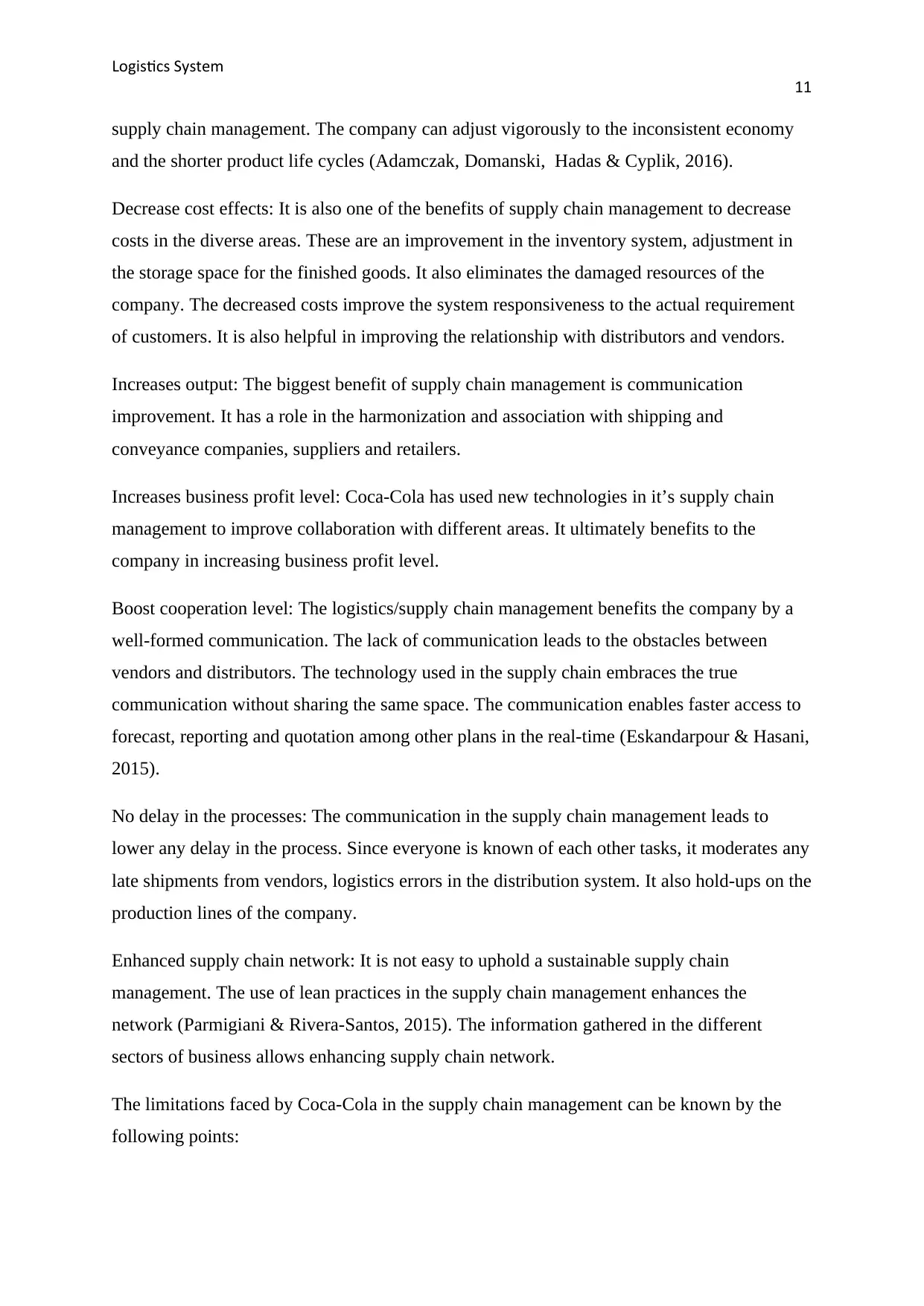
Logistics System
11
supply chain management. The company can adjust vigorously to the inconsistent economy
and the shorter product life cycles (Adamczak, Domanski, Hadas & Cyplik, 2016).
Decrease cost effects: It is also one of the benefits of supply chain management to decrease
costs in the diverse areas. These are an improvement in the inventory system, adjustment in
the storage space for the finished goods. It also eliminates the damaged resources of the
company. The decreased costs improve the system responsiveness to the actual requirement
of customers. It is also helpful in improving the relationship with distributors and vendors.
Increases output: The biggest benefit of supply chain management is communication
improvement. It has a role in the harmonization and association with shipping and
conveyance companies, suppliers and retailers.
Increases business profit level: Coca-Cola has used new technologies in it’s supply chain
management to improve collaboration with different areas. It ultimately benefits to the
company in increasing business profit level.
Boost cooperation level: The logistics/supply chain management benefits the company by a
well-formed communication. The lack of communication leads to the obstacles between
vendors and distributors. The technology used in the supply chain embraces the true
communication without sharing the same space. The communication enables faster access to
forecast, reporting and quotation among other plans in the real-time (Eskandarpour & Hasani,
2015).
No delay in the processes: The communication in the supply chain management leads to
lower any delay in the process. Since everyone is known of each other tasks, it moderates any
late shipments from vendors, logistics errors in the distribution system. It also hold-ups on the
production lines of the company.
Enhanced supply chain network: It is not easy to uphold a sustainable supply chain
management. The use of lean practices in the supply chain management enhances the
network (Parmigiani & Rivera-Santos, 2015). The information gathered in the different
sectors of business allows enhancing supply chain network.
The limitations faced by Coca-Cola in the supply chain management can be known by the
following points:
11
supply chain management. The company can adjust vigorously to the inconsistent economy
and the shorter product life cycles (Adamczak, Domanski, Hadas & Cyplik, 2016).
Decrease cost effects: It is also one of the benefits of supply chain management to decrease
costs in the diverse areas. These are an improvement in the inventory system, adjustment in
the storage space for the finished goods. It also eliminates the damaged resources of the
company. The decreased costs improve the system responsiveness to the actual requirement
of customers. It is also helpful in improving the relationship with distributors and vendors.
Increases output: The biggest benefit of supply chain management is communication
improvement. It has a role in the harmonization and association with shipping and
conveyance companies, suppliers and retailers.
Increases business profit level: Coca-Cola has used new technologies in it’s supply chain
management to improve collaboration with different areas. It ultimately benefits to the
company in increasing business profit level.
Boost cooperation level: The logistics/supply chain management benefits the company by a
well-formed communication. The lack of communication leads to the obstacles between
vendors and distributors. The technology used in the supply chain embraces the true
communication without sharing the same space. The communication enables faster access to
forecast, reporting and quotation among other plans in the real-time (Eskandarpour & Hasani,
2015).
No delay in the processes: The communication in the supply chain management leads to
lower any delay in the process. Since everyone is known of each other tasks, it moderates any
late shipments from vendors, logistics errors in the distribution system. It also hold-ups on the
production lines of the company.
Enhanced supply chain network: It is not easy to uphold a sustainable supply chain
management. The use of lean practices in the supply chain management enhances the
network (Parmigiani & Rivera-Santos, 2015). The information gathered in the different
sectors of business allows enhancing supply chain network.
The limitations faced by Coca-Cola in the supply chain management can be known by the
following points:
⊘ This is a preview!⊘
Do you want full access?
Subscribe today to unlock all pages.

Trusted by 1+ million students worldwide
1 out of 19
Related Documents
Your All-in-One AI-Powered Toolkit for Academic Success.
+13062052269
info@desklib.com
Available 24*7 on WhatsApp / Email
![[object Object]](/_next/static/media/star-bottom.7253800d.svg)
Unlock your academic potential
Copyright © 2020–2025 A2Z Services. All Rights Reserved. Developed and managed by ZUCOL.


